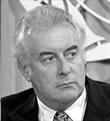DEPARMN OF
NQ DATE
M/ 97 6 July 1974
U. S. S-R./ AUSTRALIA SCIENTIFIC EXCHANGES AGREEMENT
T -he Prime Minister and Acting Foreign Minister,
Mr Whitlam, today announced the first stage in the
implementation of the U. S. S. R./ Australia Scientific Exchanges
Agreement. This, he said, was the appointment of convenors of
five groups of Australian scientists who, with their Soviet
counterparts, would study the possibilities for scientific
cooperation between Australia and the including
the establishment of joint research programs.
The Scientific Exchanges Agreement was initialled
in Canberra in February this year during the visit to Australia
of a Soviet Scientific Delegation.
During the visit the Delegation agreed with
Australian Officials on the establishment of five working
groups of scientists to investigate areas of possible
scientific cooperation.
The five groups will be in the fields of radio
0 astronomy, the earth sciences, entomology, plant industry and
textile technology. The initial meetings of the groups will probably
start during September in Moscow.
The Australian convenors for these groups, and their
Soviet counterparts are, respectively:
Radio Dr J. P. Wild, FRS, Mr V. S. Troitsky,
Astronomy Chief, CSIRO Division Deputy Director Scientific
of Radiophysics. Research Radiophysics
Institute of the Ministry of
Higher and Middle Specialised
Education of the RSFSR.
Earth Mr I. E. Newnham, Mr V. A. Magnitsky,
Sciences Director, CSIRO Chief of Laboratory Research
Minerals Research Institute of Earth Physics,
Laboratories. USSR Academy of Science.
Corresponding member of the
USSR Academy of Science. ./ 2
Entomology Plant Industry
Textile Technology Dr D. F. Waterhouse, FRS,
Chief, CSIRO Division of
Entomology. Dr L. T. Evans, Chief,
CSIRO Division of Plant
Industry.
Dr M. Lipson,
Chief, CSIRO Division of
Textile Industry. Mr M. S. Gilyarov,
Chief of the Laboratory
of Evolved Morphology
and Animal Ecology, USSR
Academy of Sciences.
Corresponding member
of USSR Academy of
Science. Mr D. oD Brezhnev,
Director Plant Research
Institute, Vavilov
and
Mr A. A. Sozinov,
Director, All USSR
Selection Genetic
Institute,
Mr B. S. Golovastikov,
Director, Central
Research Institute of
Textile Industry, Mos*.
Mr Whitlam said that other members of the Australian
groups had already been chosen. He added that the Scientific
Exchanges Agreement was an important step in furthering bilateral
relations between Australia and the It would also
benefit the scientific communities of both countries.

